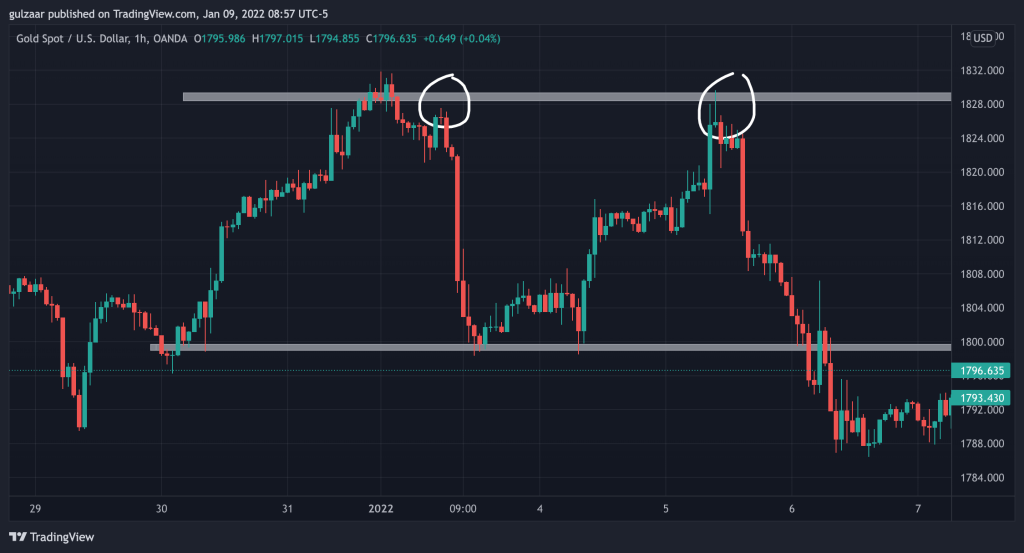Risk management is the most important thing you need to develop if you want to succeed in the Forex market. Successful Forex traders understand that it’s not the strategy or indicators that make you profitable, but it’s a sound risk management strategy.
10 Forex Risk Management Strategies
1. Trade what you can afford to lose
The most important rule to manage risk in Forex trading is to use as your trading capital money you can afford to lose.
If it’s your rent or grocery money, keep it in the bank and use it to pay your bills.
Also, NEVER, I repeat, NEVER borrow money to speculate in the Forex market.
In the beginning, Forex trading is very taxing on your psychology. Even though the prospect of making money is exciting, the fear of losing money is a much stronger emotion.
Your brain goes haywire when you trade.
Losing actually makes you want to risk more money on the next trade, thinking you can make it back. Soon enough, you’ll see you’re down even more, and you’ll be tempted to risk even more money to make the lost money back and you’ll find yourself losing money rapidly.
Sound familiar? At this point, you’re no longer trading, but you’re gambling with Junior’s college fund.
If you trade with money that you are OK with losing, you won’t be as tempted to take stupid trades and blow your trading account.
The temptation is still there, trust me. But it’s just easier to control.
If you don’t have that much money to trade right now, don’t worry. Some brokers even let you trade with as little as $100. After you get confidence in a demo account, start a $100 account and take live trades on it.

2. Make a trading plan
Have you heard the adage: “Fail to plan, plan to fail?”
This saying holds incredibly true for Forex trading.
Many traders like to jump into the Forex market without the proper planning.
In order to succeed in Forex trading, you need oto have the discipline to make a Forex trading plan and stick to the plan.
A good trading plan can just be a simple document that details the times that you will sit to trade, conditions that must be met for you to enter a trade, how you will exit a trade, when you’ll walk away from the markets, and your risk management rules.
Your trading plan is going to be your trading lifeline. Print it out and stick it somewhere on your desk that you can see it at all times.
Every time you sit at the charts, read your trading plan to refresh it.
Then only sit and trade.
I’ll share my experience. I used to think trading plans are for losers. But I blew 4 prop firm challenges trying to trade without a plan.
By documenting your rules for trading, you are able to reign in your worst instincts that kick in when you sit and trade the financial market.
3. Always use a stop loss and profit target
If you’re under the impression that stop losses are for wimps, walk away from trading right now.
One of the biggest reasons many forex traders(especial retail traders) blow their trading account is because they don’t use a stop loss.
Whenever you place a trade, you have no idea whether the market price of your chosen currency pair will go your way or against you. That’s why you need to use a stop loss to prevent yourself from losing more money than what you’re prepared to risk.
The level of your stop loss will depend on the trading setup and your risk tolerance.
Also, once you set your stop loss, do not move the stop loss further from your trade level.
This can put you in a very vicious cycle when price turns against you, suckering you into moving your stop loss further and further away, hoping the trade will eventually turn your way.
If your trade goes against you, man up and take the loss. There will always be another trade.
In some cases, you can make your trading plan such that you’ll move your stop loss to break-even after your trade has gone a certain number pips in your direction.
This is fine, and is actually sound risk management.
Some traders even prefer to close a percentage of their position once they’ve hit a few pips in profit, then move the stop loss to break-even and let the trade run.
This will depend on your trading strategy and trading plan.
You should also use a take profit target in your trading. Ideally, you shouldn’t get in a trade unless you know where you’re going to get out of the trade.
Use a conservative level to get out, and let your take profit order close your position.
When a trade goes your way, it’s tempting to let it run forever, but the Forex market is very temperamental and can reverse any time.
When the market gives you some profit, TAKE IT.
If you want more, close out a majority of your position at your take profit level and let the rest run. This way you’ve secured profits and removed all risk.
4. Calculate your maximum risk per trade
Before you place even a single trade, you must know what your maximum risk per trade is. This is the cornerstone of all risk management rules: you can only lose a set amount per trade, not more.
Many traders risk 2% per trade in the start when they still have smaller accounts. As their accounts grow, they reduce the risk to 1% or even 0.5%.
Whatever number you decide on, you must stick to it.
However your account fluctuates, your trade sizes will, too.
If you start with a $100 account, you’ll risk 2% or $2 per trade. As your account doubles to $200, you’ll now risk $4 per trade.
You don’t have to risk 2%. You can even be more conservative and risk 1%, or you may be in profit for the week and decide to risk a little more.
The point is, you must decide an amount that you are comfortable losing and risk that much.
Taking excessively high risk trades that can blow an entire account is not fun.
5. Calculate your position size according to your risk
Once you’ve decided how much you’re willing to risk, you’ll use that to determine your position size in your trade.
So if you have a $1000 in your account and you’re risking 2% per trade, you can lose a maximum of $20.
Next, you determine where your stop loss is and use that to calculate your position size.
If your account’s base currency is USD and you’re trading a USD pair, pip values are fairly easy to calculate.
With a micro lot, one pip is $0.10
With a mini lot, one pip is $1
With a standard lot, one pip is $10.
If you’re trading a cross pair, you’ll need to do a bit more math. To make life easier, just use a pip value calculator like the one at MyFXBook.com.
To make life even easier, use a tool like Magic Keys to open and manage your trades.
Going back to the original example of $20 to lose with a 20 pip stop loss, you can place a trade with a position size of one mini lot.
More: What’s the best lot size for $1000?
6. Have a good risk-reward ratio
The next step is to have a good risk to reward ratio.
On every trade, you want to make more money than you stand to lose. This is your risk to reward ratio.
Go for risk to reward ratios of at least 1:1.5 or more. This way, even if you lost half of all trades you took, you’ll still be profitable.
At a risk to reward ratio of 1:1.5, you’d want to make 15 pips if you were risking 10.
Proper risk management means you’re factoring in losing trades.
Of course, your take profit level must also be reasonable. If your target is beyond an extremely strong level that price has not broken in a long time, you’re probably not going to hit it.
7. Try to find trades at key levels
One way to get really high risk to reward trades is to find trades at key levels.
Key levels are those where price has historically seen very strong movement. Here’s an example from EUR/USD:

Notice how every time price reaches $1.1360 in this timeframe, there’s aggressive selling.
There are potentially huge moves happening here where you could target a good chunk of pips for comparatively little risk.
Here’s another example from XAU/USD:

Notice how price climbs up to those levels very slowly, but there’s aggressive selling(big candles) from those key levels.
8. Scale down if you experience a few losses
Losing trades are a reality of the Forex markets. The best traders also experience losses, but what sets them apart from newbie traders is that they don’t let losing trades play with their head.
Instead, pro traders scale down their positions and risk less money per trade until they start winning again.
This minddset creates the next best thing to a fully risk-free environment.
One thing that really destroys new Forex traders(and myself too in the past) that they become married to their initial trading idea.
If they lose the first time, they’ll double down and try to take the same position again.
While it’s sometimes a good strategy to give your bias a second chance, you need to keep your risk in check.
If you typically risk 1% per trade, try to risk just 0.5% after a string of losses until you get your confidence back.
9. Don’t worry about leverage if you’re managing risk
A lot of the educational resources regarding Forex trading make a huge deal of leverage and how it can destroy your trading capital.
While this is true, leverage is not really the monster it’s made out to be PROVIDED you have good risk management strategies in place.
Let me explain with an example:
Let’s say you’re looking to open a position of 1 standard lot on a $10,000 account and you have a 20 pip stop loss, which means the most you’ll lose is $200 or 2% of your account.
You need $100,000 to open the position, so the minimum leverage you need is 1:10.
Now, if you’ve got a stop loss in place that ensures you only lose $200 in case the trade goes against you, what does it matter if your leverage is 1:10 or 1:500?
Leverage becomes a problem and margin carries significant risk when you start risking a lot more than the 2% you should be risking.
If you had 1:500 leverage, you could open a position of $5,000,000 or 50 standard lots on a $10,000 account. With 50 lots, one pip is about $500.
That means 20 pips in the red can wipe out your account.
Again, if you have a rule for how much you’re willing to lose per trade, you would never over-extend yourself like that.
More: Forex trading vs binary options
10. Practice on a demo account
Finally, once you’re armed with all this knowledge, practice your trading skills on a demo account before you open a live account and stand to really lose money.
Building up your trading skills, understand how the trading session makes your currency pair of choice move, and finding good entries takes a lot of practice.
Once you’re confident that you are profitable on a demo account, start trading a live account or take a prop firm challenge and build up to significant capital.
Related:
Conclusion
Remember, no matter how good your trading system is, if you don’t have a risk management plan in place, you’re going to lose money faster than you can make it. The secret to success in the foreign currency market is to be aware of the risks involved and turn your weakness into strength.
Only trade money you’re willing to lose, and only be prepared to lose a small amount per trade.
